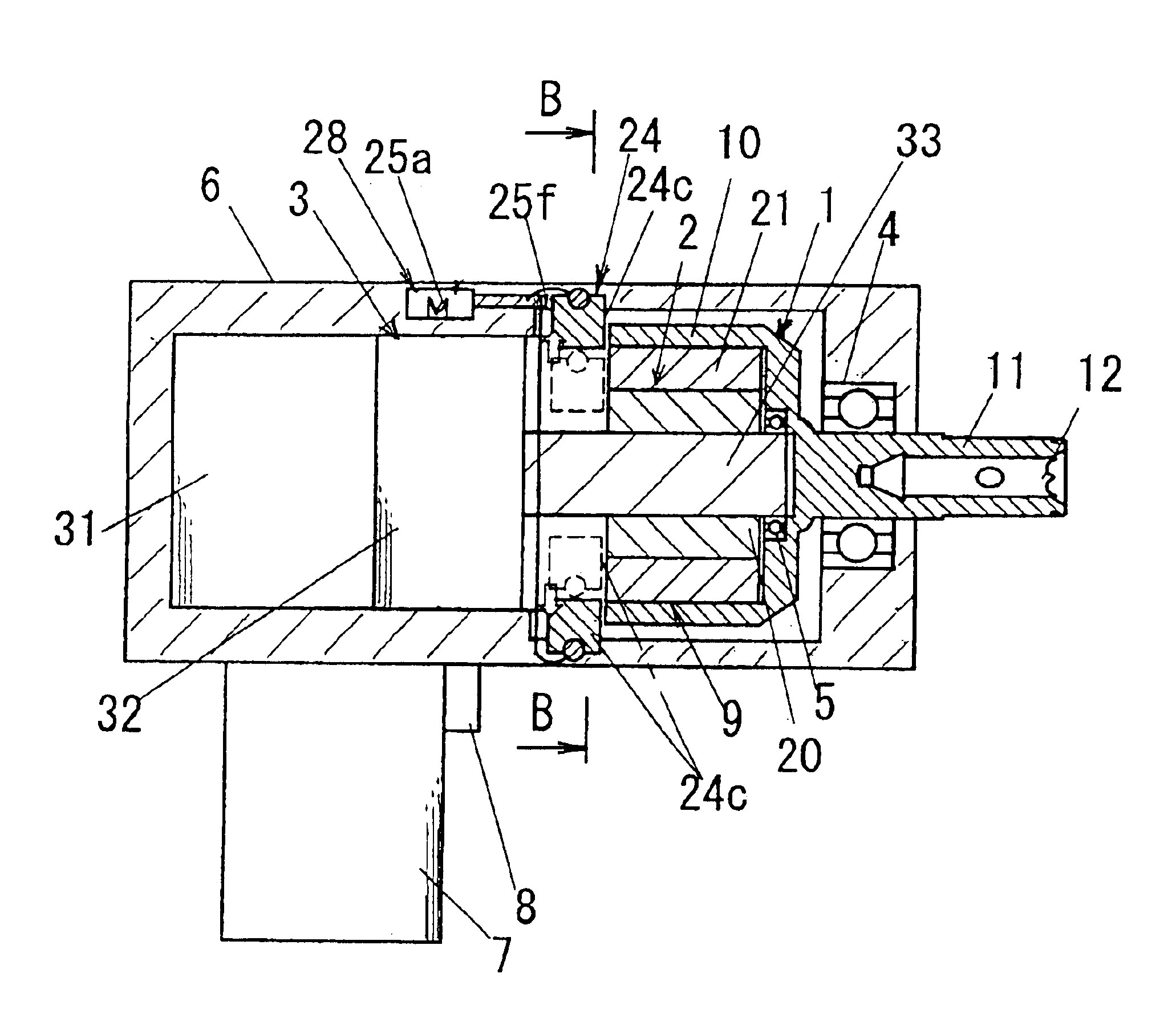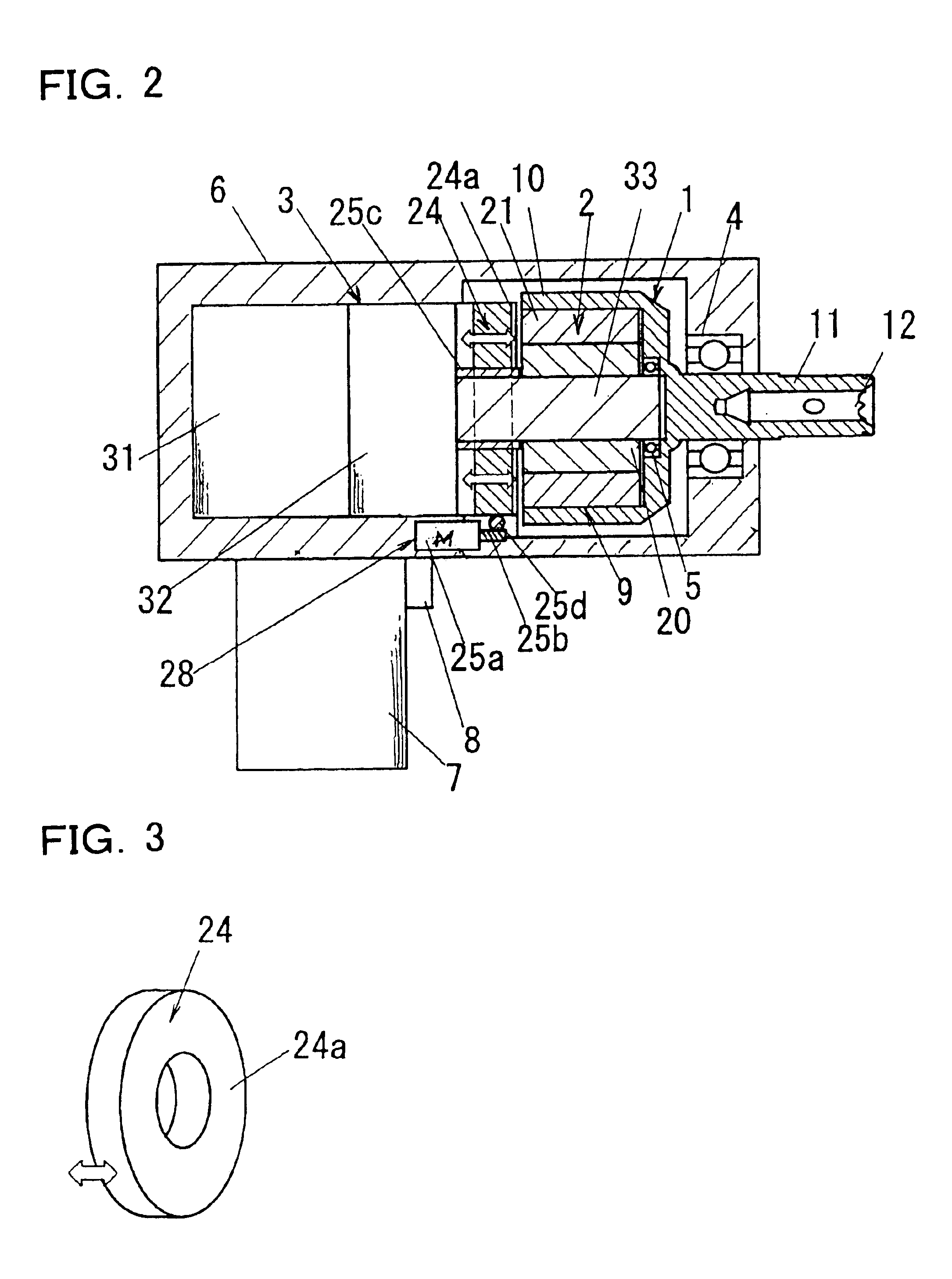Magnetic impact tool
a technology of magnetic impact and tool, which is applied in the direction of manufacturing tools, percussive tools, portable drilling machines, etc., can solve the problems of inability to carry out tightening and loosening work, inability to use, and inability to tighten and loosen work, so as to facilitate handling, simplify the configuration of the changing device, and reduce the total length of the tool.
- Summary
- Abstract
- Description
- Claims
- Application Information
AI Technical Summary
Benefits of technology
Problems solved by technology
Method used
Image
Examples
first embodiment
[0042](First Embodiment)
[0043]FIGS. 1 to 3 show a magnetic impact tool (hereinafter referred to as tool) according to the first embodiment of the present invention. The basic structure of this tool is the same as the structure for generating impact torque in a non-contact manner shown in the above-described FIGS. 15 to 17; the same symbols are assigned to common portions and their description is omitted (the same applies hereinafter); and characteristic structures are assigned new symbols and described. This tool comprises a magnetic bypass device 24 for distributing magnetic flux between the magnetic anvil 1 and the magnetic hammer 2, and a changing device 28 for changing the distribution of magnetic flux by the magnetic bypass device 24. In this tool, the distribution ratio of the magnetic flux that flows from the magnetic hammer 2 to the magnetic anvil 1 and the magnetic bypass device 24 can be varied by means of the changing device 28. The torque generated between the magnetic h...
second embodiment
[0050](Second Embodiment)
[0051]FIGS. 4 and 5 show a magnetic impact tool according to the second embodiment. In this embodiment, an annular plate 24a composed of a magnetic material as a magnetic bypass device 24 is provided with an enlarged hole diameter, and is mounted with a tolerance on the drive axle 33. The plate 24a has a shaft 27 that is orthogonal to the axial center of the magnetic hammer 2 in a position outside of or on the external periphery of a magnetic hammer 2, and this shaft 27 is rotatably supported by bearings 61 disposed in the case 6. The changing device 28 has a return spring 26 and a solenoid or other direct-acting actuator 25e for causing the plate 24a to tilt. The magnetic flux distribution from the magnetic hammer 2 to the magnetic anvil 1 can be changed and the torque generated on the magnetic anvil 1 varied by tilting the plate 24a with the changing device 28. Here, the plate 24a is tilted by the tensile force of the actuator 25e, and when the drive of th...
third embodiment
[0053](Third Embodiment)
[0054]FIGS. 6 and 7 show a magnetic impact tool according to the third embodiment. In this embodiment, the magnetic bypass device 24 is configured with a spiral spring 24b composed of magnetic material. The internal end portion of the spiral spring 24b has an initial position in the vicinity of the end face of the magnetic hammer 2, and the external end portion of the spiral spring 24b is fixed to the case 6. The changing device 28 is configured with a direct-acting actuator 25e that is linked to the end of the internal end portion of the spiral spring 24b. When the internal end portion of the spiral spring 24b is pulled by the actuator 25e in a direction parallel to the drive shaft 33, the spiral spring 24b can be elastically deformed, then, the distribution of the magnetic flux between the magnetic hammer 2 and magnetic anvil 1 is changed. Consequently, the torque generated on the magnetic anvil 1 can be varied. By reversing the actuator 25e and eliminating...
PUM
| Property | Measurement | Unit |
|---|---|---|
| rotational impact force | aaaaa | aaaaa |
| rotational force | aaaaa | aaaaa |
| magnetic flux | aaaaa | aaaaa |
Abstract
Description
Claims
Application Information
 Login to View More
Login to View More - R&D
- Intellectual Property
- Life Sciences
- Materials
- Tech Scout
- Unparalleled Data Quality
- Higher Quality Content
- 60% Fewer Hallucinations
Browse by: Latest US Patents, China's latest patents, Technical Efficacy Thesaurus, Application Domain, Technology Topic, Popular Technical Reports.
© 2025 PatSnap. All rights reserved.Legal|Privacy policy|Modern Slavery Act Transparency Statement|Sitemap|About US| Contact US: help@patsnap.com



